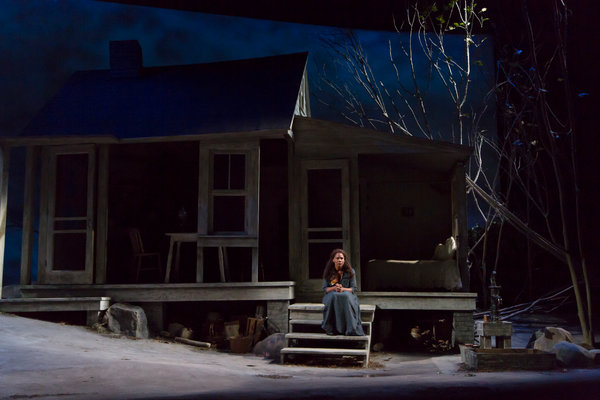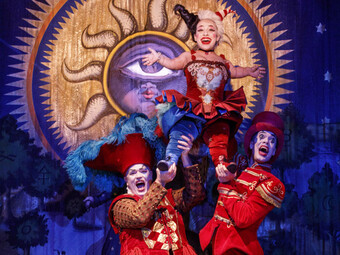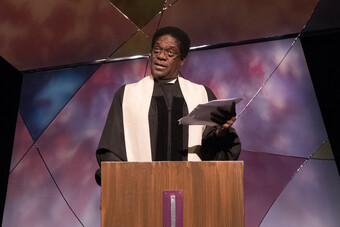Trouble with the Classics
A Moon for the Misbegotten at Williamstown
How do we keep reviving the classics while making sure that their concerns continue to speak to our own? I found myself contemplating that commonly asked question with particular concern as I walked out of the Williamstown Theatre Festival’s A Moon for the Misbegotten, starring Audra McDonald and Will Swenson.
A Moon for the Misbegotten is an American classic, but it’s also a strange play. Eugene O’Neill’s drama follows the relationship of Josie Hogan and Jim Tyrone over the course of roughly twenty-four hours. Tyrone is the landlord of Josie and her father Phil, who are poor farmers in Connecticut. He’s very friendly with the Hogan’s, but we come to learn that he’s also a profoundly flawed man who’s effectively a walking corpse, spiritually dead and watching his health rapidly deteriorate. He has fallen to pieces over his awful behavior during and after his mother’s death; when the play begins, he’s very close to having succeeded at drinking himself to death. Tyrone carries on a flirtation with Josie, who loudly professes her licentiousness to anyone who will listen but who secretly remains a virgin. It looks as though they may sleep together, but instead the play culminates with Tyrone lying in Josie’s arms under the titular moonlight and confessing his sins, leading to a sort of redemption that saves his soul, though not his life.
How do we keep reviving the classics while making sure that their concerns continue to speak to our own?
The show has a lot to recommend it: McDonald’s predictably fantastic as Josie Hogan,and both Swenson (James Tyrone, Jr.) and Glynn Turman (in the role of Phil Hogan) shine in certain moments. (To read a more conventional review I wrote on this subject, go here.) Turman has a number of very funny and touching beats, especially in the final act. For his part, Swenson really hits his stride in the play’s centerpiece, his scene in the moonlight with Josie. Yes, he and McDonald are married to one another in real life, but that doesn’t fully account for the easy, natural chemistry the two of them have. It’s a delight to watch them interact, and McDonald in particular projects a beatific radiance in the scene where she cradles Swenson’s Tyrone in her arms on the stairs of her home.
Speaking of those stairs, I found both the set and the lighting especially impressive. The former is apparently an updated version of Ming Cho Lee’s set from an earlier production. It was clearly worth keeping, because it creates a fascinating, multi-leveled space for the actors to explore. Jennifer Tipton’s lighting also looks great. That’s especially important, because depicting the cycle of day and night is so important to understanding the rhythm of this play.
In addition to the big names in the cast, the show also attracted attention for its introduction of a racial dynamic to the relationship between Tyrone and the Hogans: McDonald and Turman are both African-American, as is Howard W. Overshown, who appears briefly at the beginning of the play as Josie’s brother Mike. Edelstein’s concept was to change the class dynamic of the original play and to take race into account as well, but I’m just happy to see someone make this casting choice, regardless of their reasons for doing so. Classical theatre’s problems with diversity are well-known by now, and if we’re going to preserve plays like Moon, as well as the qualities that make them valuable and worth reviving, then we need to consider expanding our conceptions of who the characters in these plays can be.
I was generally pleased with Gordon Edelstein’s direction, although he did make one major change that gave me pause. That change comes during an ugly moment where it looks like Tyrone may very well force Josie into having sex with him. In Act III, when Tyrone tells her that he loves her, she confesses her virginity and then, according to O’Neill’s stage directions, “kisses him with fierce passion.” That kindles something dark in Tyrone, who responds by beginning to talk to Josie as if she were a prostitute and handling her roughly. As Tyrone is doing this, O’Neill specifies that he “pushes [Josie] back in the doorway,” at which point “She pulls his arms away so violently that he staggers back and would fall down the steps if she didn’t grab his arm in time.” Tyrone falls to his knees, asking “confusedly, as if he didn’t know what had happened,” “What the hell? Was I trying to rape you, Josie?” He starts to argue that he was drunk and didn’t know what he was doing, but cuts himself short: “Nuts! Cut out the faking. I knew what I was doing. … But it’s funny. I was seeing things.”

We’re meant to understand that Tyrone’s actions, however deplorable, really were largely the result of his drunkenly flashing back to a pivotal incident in his life involving a prostitute, which constitutes the climax of his crucial confession later in the play. O’Neill is certainly not excusing the character’s actions, but I think it’s worth noting how carefully he details those actions and their context. Tyrone is responsible for a lot of bad things, and he’s capable of committing a serious sexual transgression, but it’s crucial that he doesn’t.
However, in the Williamstown production, Edelstein takes the scene far past the moment where Tyrone pushes Josie and she, in turn, nearly sends him tumbling off of the stairs. As Swenson and McDonald play it, the incident really does come off as a rape attempt. Rather than stopping at the door, Swenson’s Tyrone pushes McDonald’s Josie all the way into her bedroom, proceeds to throw her down on the bed, and has his pants down to his ankles before she gives him a kick that sends him flying across the room. Furthermore, his delivery of Tyrone’s subsequent lines comes off as significantly more self-justifying than in the script: his “Was I trying to rape you?” sounded like a rhetorical question, rather than an at least semi-sincere inquiry.
It’s the most shocking moment of the production, and I have to admit that it was hard for me to get over it. This production’s Tyrone is so close to being an actual rapist that it’s hard to ever fully get back on his side, especially because the play is about his being forgiven for his past actions. Seeing him very nearly commit such a heinous act onstage took away much of my sympathy for him, leaving me questioning whether he really deserved to be absolved by Josie. Maybe this was precisely Edelstein’s intention.
Rape has, quite rightly, become an issue that’s gotten major attention in recent years. Tyrone’s actions in O’Neill’s script are already questionable—both by the historical standards of when the play was written (the 1940s) and by our contemporary reality. The Williamstown production all but marks Tyrone as a rapist, distorting the workings of the play in a significant way. By our standards, it’s behavior that is arguably more egregious than the sins to which Tyrone ultimately confesses, and the fact that he and Josie move past it relatively quickly makes it look as though she’s a doormat, rather than a strong female character.
It strikes me that twenty-first-century productions of the American theatrical canon have to grapple with some of those plays’ assumptions and blind spots in the same way that we’ve had to wrestle, for a much longer time, with disturbing aspects of the classical canon.
It strikes me that twenty-first-century productions of the American theatrical canon have to grapple with some of those plays’ assumptions and blind spots in the same way that we’ve had to wrestle, for a much longer time, with disturbing aspects of the classical canon. The Taming of the Shrew and The Merchant of Venice are just the two most prominent examples of Shakespearean plays that seem difficult, if not impossible, to stage without significantly reimagining, or even rewriting, them. That task is made easier by the fact that Shakespeare’s work is so famously flexible: we can rearrange or cut certain passages, or set the action in a completely different context that highlights the plays’ knottiest problems. That’s harder to do with some of the American classics, especially O’Neill, whose exacting (and lengthy) stage directions establish a very specific setting that’s harder to make abstract than, say, the generalized setting of Venice or Padua.
Making the encounter between Josie and Tyrone about rape might touch on an issue that’s much more prominent in our time than in O’Neill’s, but in this case I found myself questioning whether it was worth it. I’m willing to bet that a number of people who weren’t familiar with Moon going into that performance walked out disliking Tyrone because of that one scene, and how could one blame them, given how his actions read onstage? On the other hand, if they did walk out hating him, then they were robbed of the chance to fully appreciate one of the most touching and profound plays in American theatrical history.









Comments
The article is just the start of the conversation—we want to know what you think about this subject, too! HowlRound is a space for knowledge-sharing, and we welcome spirited, thoughtful, and on-topic dialogue. Find our full comments policy here